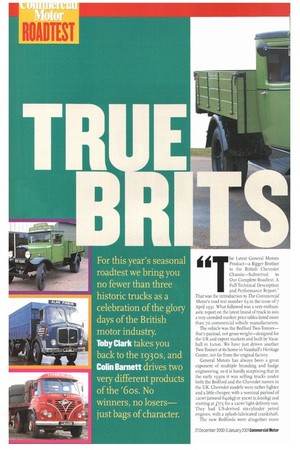he Latest General Motors Product—a Bigger Brother to the British
Page 68

Page 69

If you've noticed an error in this article please click here to report it so we can fix it.
Chevrolet Chassis—Submitted to Our Complete Roadtest. A Full Technical Description and Performance Report." That was the introduction to The Commercial Motor's road test number 63 in the issue of 7 April 1931. What followed was a very enthusiastic report on the latest brand of truck to join a very crowded market price tables listed more than 70 commercial vehicle manufacturers.
The vehicle was the Bedford Two-Tonnerthat's payload, not gross weight—designed for the UK and export markets and built by Vain& hall in Luton. We have just driven another Two-Tonner at its home in Vauxhall's Heritage Centre, not far from the original factory.
General Motors has always been a great exponent of multiple branding and badge engineering, so it is hardly surprising that in the early 1930s it was selling trucks under both the Bedford and the Chevrolet names in the UK. Chevrolet models were rather lighter and a little cheaper, with a nominal payload of rzcwt (around 64okg) or 3ocwt (i,600kg) and starting atit75 for a 12.cwt light delivery van. They had US-derived six-cylinder petrol engines, with a splash-lubricated cranksha The new Bedfords were altogether more robust: the four-bearing crankshaft was pressurefed, though it shared the Chevrolet's X 31,in bore and stroke for a displacement of 3,177cc—or 194cu in, if you prefer—and the rear axle was rather stronger. A hefty riveted chassis and twin rear wheels confirm the design's serious intent; short (13110) wheelbase (WHG) and long (157in) wheelbase (WLG) chassis were available at /198 and faro respectively. Later in 1931, bus variants were launched: a shortwheelbase WHB chassis fitted with a 4-seater Grose service-bus body was shown at the loth Olympia Show that year, priced at /47o all in.
The new models proved instantly successful, and the public took to the Bedford name; in fact, Chevrolet tucks had disappeared as a brand in the UK by the end of 1932 as lighter Bedfords came on to the market.
Our test vehicle is a short-wheelbase WHC in excellent condition, fitted with all the correct ancillaries—all the more impressive as it was rebuilt from two 1931 chassis described as "near scrap" by Ray Cooper, senior vehicle restorer at the Heritage Centre. It has a factory-style dropside body and is painted in authentic Grass-Green and black cellulose paints. This chassis spec would have cost /240.
The chassis-only kerbweight was 3,18olb (1,34kg), with a plated "not to exceed" (gross) weight of 9 ,27olb (4,414kg) for a bud load allowance of 2,90 okg. With the l; specified the payload goes down to 2,3c still not bad by modern standards, and two tons however you measure it.
The Bedford's overhead-valve "six" quoted output of 444, at a low (by i standards) 2,4 oorpm. It breathes thn single Zenith U12, carburettor; CM's helpfully comments that "the U type it for its accessibility", and in fact every the drive train is easy to reach. Unusu the day, the engine is fitted with both cleaner and a cartridge-type oil filter.
The electrics are six-volt, with a Del( erator and starter—no hand-cranking] here—and coil-and-distributor ignitio WHG we drove recently had a Delco di tor, though the tested in 1931 Lucas item. Apa the electric pump—the fut lives beneath ver's seat—an lights, nothin; troubles the I even the single is vacuum oper The foul gearbox is corn
"cra sh"—Alvis wouldn't fit the first synchromesh box to its cars for another year or two, though ZF devised a synchronised gearshift in the late t92os. The brakes are dated, tc self-energising shoes are operated by n cables, without a hint of a servo; tin brake operates separate shoes on the re Oddly. CM's contemporary test says:' the handbrake did not help the braid formance. This is due to the human limi Don't be so hard on yourselves, chaps!








































































































































